When you put Baton Rouge, Louisiana, on your itinerary, the first thing you think about is big-time college football. This is the place of legends.
But as you venture down to the bayou, you leave stunned by the fact, that’s there so much more to the state’s capital city than LSU and Southern University, the two renowned academic and athletic institutions.
“Here in Baton Rouge, you’ve got good food, good culture, good history,” said Amy Province, the city’s market executive for Regions Bank. “There’s so much here. And part of the story of Baton Rouge is the seat of government. Combine that with a world-class athletic environment and it’s an experience like no other.”
This is a place where you can’t miss a meal – but only if you aren’t exhausted first. Because when it comes to Good Towns, our latest is place of wonderment on all levels. So put on your best walking shoes and join us for our latest virtual tour.
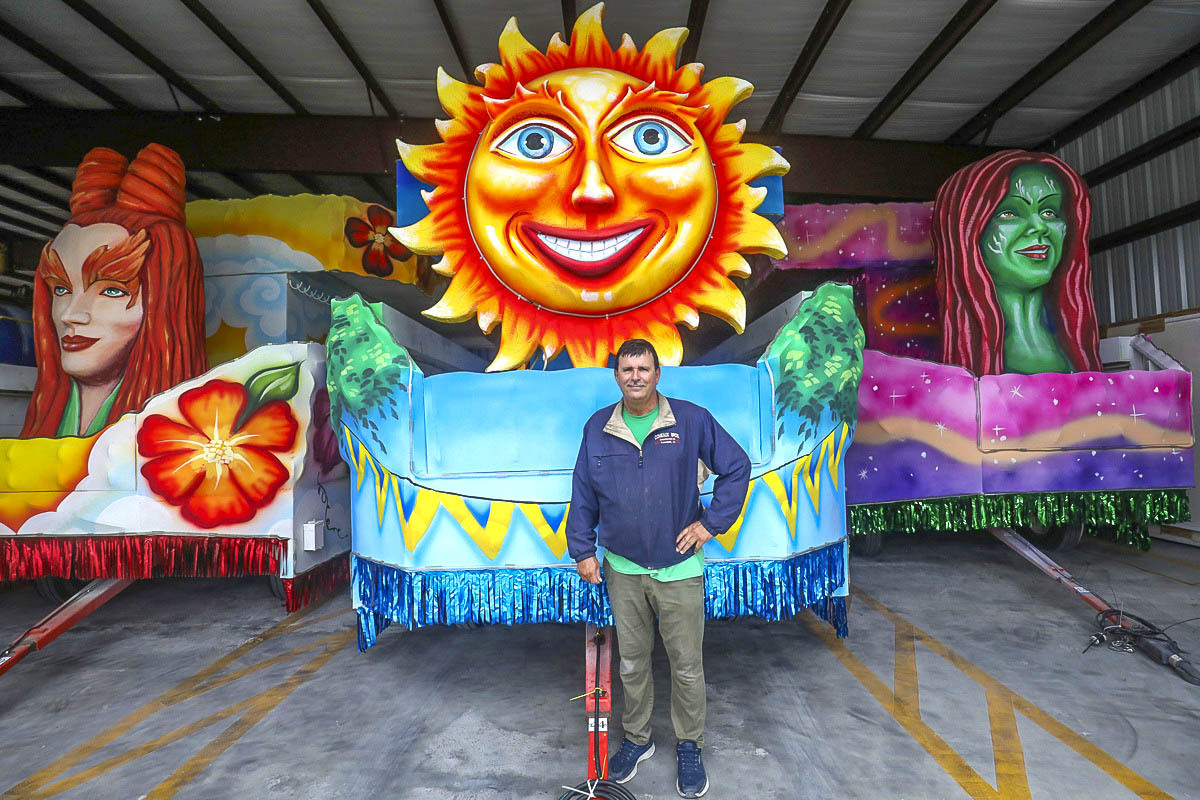
For more than a decade Earl Comeaux has built parade floats, all in honor of his late sister. / GARY TRAMONTINA PHOTOS

Earl Comeaux and Sedric Chaney work on their next build at Comogo Floats. Comeaux uses a level while Chaney stretches a tape measure to ensure accuracy.

Shelves full of parade throws line the warehouse at Comogo Floats LLC.

The head of a court jester stands on guard at the entrance to the warehouse at Comogo Floats.

Three floats with three vastly different stories.

Earl Comeaux explains his inspiration from one of his recent floats, a colorful train.

At Comogo Floats, a swan’s head meets a float featuring a Carmen Miranda-like dancer.

A swan’s head awaits visitors at Comogo Floats.

Earl Comeaux’s passion for mixing solid construction with art is on display at Comogo Floats.
Floating on a Dream
Inside a Plaquemine warehouse just outside the city proper, Earl Comeaux navigates a maze of dozens of parade floats that show off his inspired creations over the last decade and a half. He’s got 49 down, but the next one is going to be special.
“There’s not a crawfish float in the entire state,” Comeaux said with a wry grin. “But for our 50th float, I want it to be special.”
In Louisiana, the party never ends. A commercial builder by trade, Comeaux started building parade floats as a tribute to his late sister. Now, it’s a fulltime occupation at the aptly named Comogo Floats LLC because the requests for help never end.
“We started this krewe for his sister, Brenda Comeaux, who died of cancer in 2009,” explained Lorie Verbois, a Regions banker and longtime friend. “She always dreamed of a nighttime parade in Plaquemine. The krewe was founded by Rhonda Harrell, with the help of Chris Daigle, Rhett Vaughn, among others.
Friends and family first honored Brenda with the parade she’d long dreamed about, but Earl and his brothers, Ralph and Darrel, immediately wanted to take things up a few thousand notches after the inaugural parade was held in freezing rain. He realized the floats rented for the occasion weren’t up to snuff.
Earl Comeaux could build bigger and better floats, with incredible amenities (including bathrooms) and shelter from the elements for revelers. And as word grew, he had to drop his day job to keep up.
“This is all I want to do,” he said. “This is my 42nd year in construction, but this is my passion now. If my sister was still here, she’d be living in the apartment upstairs because she’d want to be a part of this every day.”
The designs range from college football mascots to Hollywood favorites, framed on solid platforms you could take into battle. For finishing touches, an artist from New Orleans arrives every Sunday. And he’ll deliver within reasonable distance.
“It’s a two-hour trip to Thibodeaux, and when we return from the parade people line up in lawn chairs to watch us,” Earl said.
They’ll spend $100,000 on a parade now – “that’s just for the (bead) throws,” Earl pointed out. But as the demand grows and orders come from across the state and beyond, he continues to create these floating tributes.
In memory of Brenda.
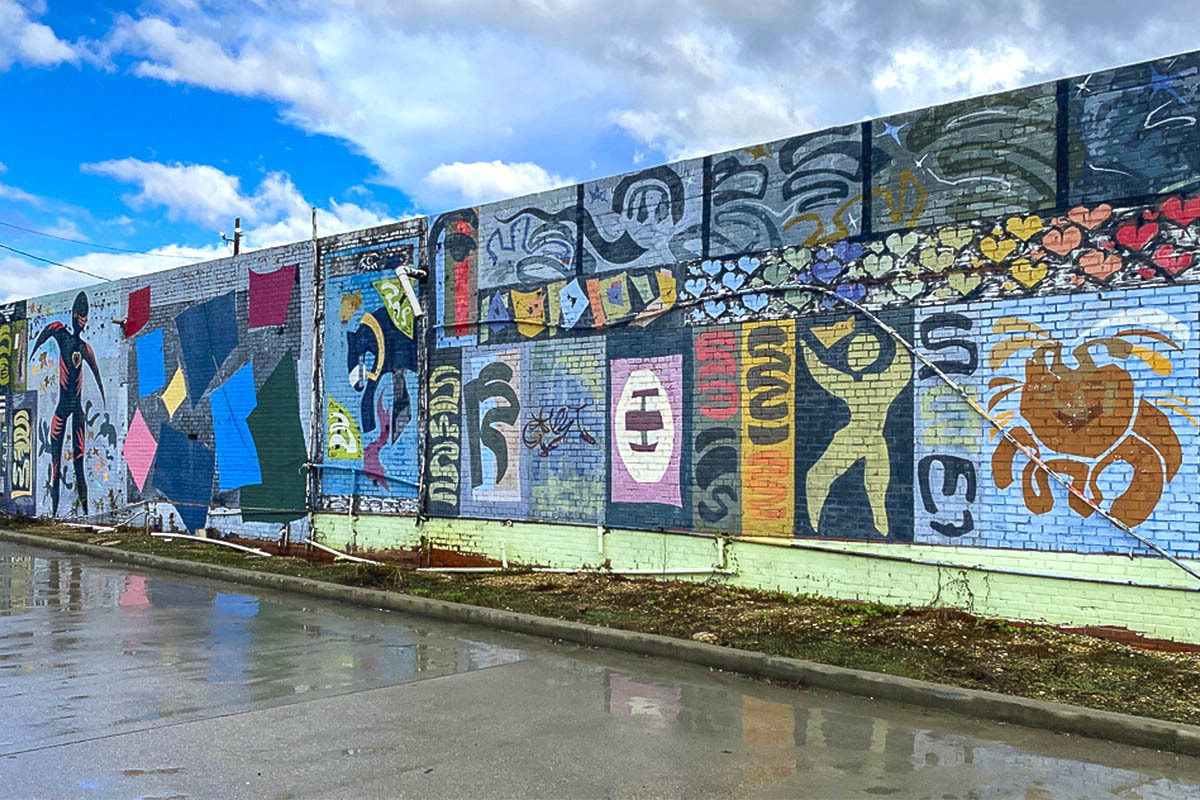
A Baton Rouge mural emphasizes the arts and delectable seafood. / GARY TRAMONTINA PHOTOS

A sign welcomes you to Electric Depot, a Mid City fixture that includes restaurants, shopping, a music venue and a bowling alley.

Pam Steinsiek first opened Mosaic Gardens in nearby St. Francisville 25 years ago before relocating to Mid City. Her store offers pottery, art and the perfect piece to make a house a home.

The exterior of Mosaic Garden offers customers a swing to sit, wares to purchase and signs to point them to great deals.

Garrett Kemp worked at Circa 1857 Antiques while in high school Today, he owns the store.

A collection of the works of Charles Dickens entices readers of literary classics at Circa 1857.

Take your time browsing Mosaic Garden in Mid City. The selection is eclectic and endless.

Swans, pelicans and egrets, oh my. Artwork on display at Circa 1857.

Antique wooden doors on display against a Circa 1857 wall.
The Heart of Baton Rouge
Once forgotten, Mid City is undergoing a 21st Century renaissance thanks to the city’s efforts to bring new businesses and artists together. In a neighborhood covered by oak trees and sandwiched between the sprawling LSU campus and downtown, Mid City includes eclectic places to eat, shop and meander.
We make a quick stop at Electric Depot, where former pop ups have brick-and-mortar storefronts dominate the urban scene.
A few blocks further down, Pam Steinsiek stands behind the counter of Mosaic Garden, which has a mix of pottery, ceramics, wall art and a variety of unique additions for the home.
“I originated it in St. Francisville 25 years ago,” Steinsiek said. “Then they asked me to be part of Circa 1857, and we made the move. Now, we’re the art district of Baton Rouge.
Across the shared parking lot stands Circa 1857 Antiques fronts Government Street. Inside, owner Garrett Kemp welcomes a steady stream of visitors who seek everything from quirky to classic. Kemp isn’t yet 30, but he worked at the antique store as a high school senior in 2012 before heading off to college. But before he graduated from the latter, the original owners made him an offer he couldn’t refuse: a chance to purchase the shop and put his personal stamp on it.
Located in an old drug store that operated from 1920 to the mid-’80s, Circa 1857 has everything from mid-century furniture to original 19th Century artwork and military prints, Kemp’s favorite.
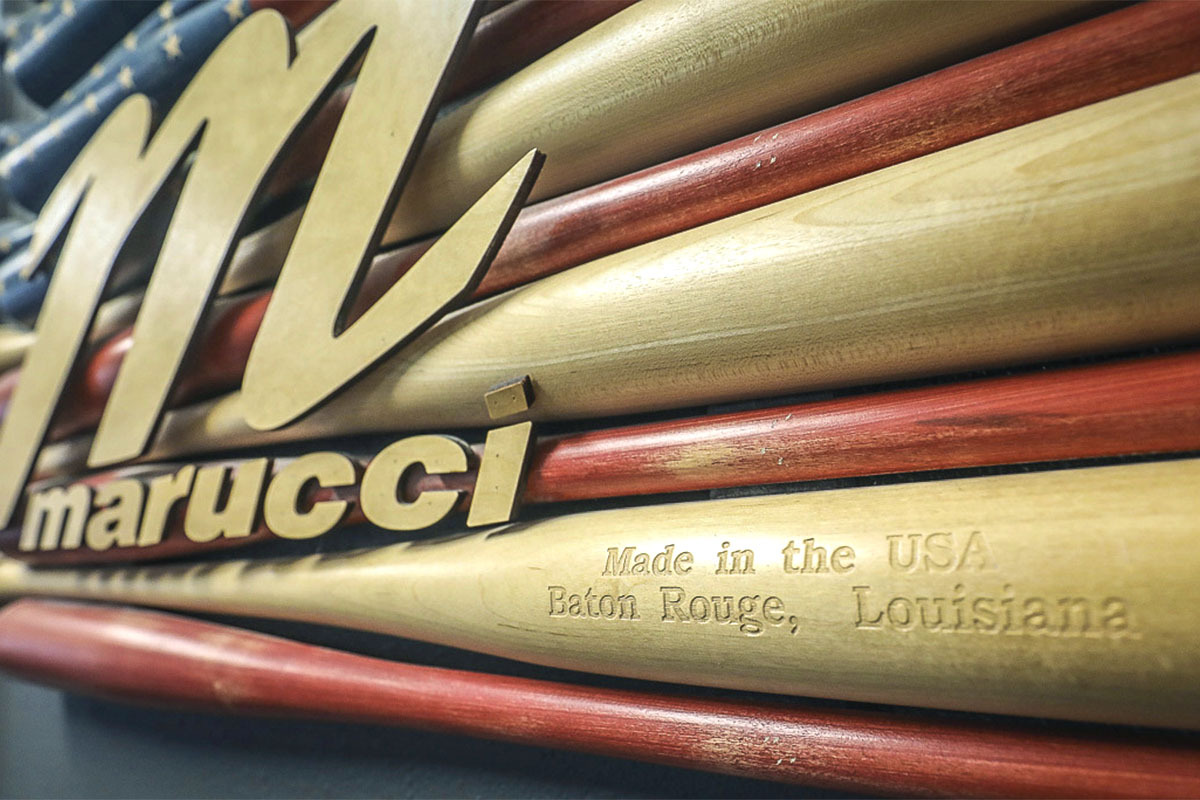
Wooden Marucci bats emblazoned with “Made in the USA/Baton Rouge, Louisiana.” / GARY TRAMONTINA PHOTOS

Michael Uffman tells the story of Marucci Sports as a team from Regions Bank look on.

Michael Uffman shows off the timeline of Marucci Sports, which in a short time has become one of the most popular brands in the world of sporting goods.

An array of wooden Marcucci bats line the wall of the company’s Baton Rouge headquarters.

A leather baseball glove at Marucci Sports.

Inside the warehouse of Marucci Sports an array of colorful wooden bats line the walls. Even the staircase rail leading upstairs is made of wooden bats.

Machines shape the wooden bats at Marucci Sports.

Workers at Marucci patiently sand down the wooden bats.

Wood stock for future big-league bats.

An assembly line of workers turn pieces of lumber into fine-tuned instruments for big-league ballplayers.

Workers line up Marucci bats for a new coat of paint.

An array of baseball bats at Marucci Sports in all colors of the rainbow.

Marucci Sports CFO Michael Uffman gives Regions Bank’s Amy Province batting tips.

Amy Province, Regions’ market executive in Baton Rouge, holds a white Marucci bat that is one of the most popular in the big leagues.

Regions’ Amy Province takes a mighty swing in the Hitter’s House batting cage at Marucci Sports.
Swinging for the Fences
What happens when two former LSU athletes spend the offseason rehabbing injuries? In the case of Kurt Ainsworth and Joe Lawrence, you team with athletic trainer Jack Marucci to craft the most popular bat in Major League Baseball.
The trio began making bats in Kurt Ainsworth’s backyard shed. Now, Marucci Sports is an athletics behemoth. And Ainsworth remains as the CEO. When we visited the company’s Baton Rouge headquarters, you had big leaguers working out in the gym and perfecting their swing in the Baseball Performance Lab.
But what really sets the facilities apart are the public-access batting cage at Hitter’s House, where anyone can test their skills in a virtual recreation of a big-league park. Beginning next year, the public will be able to tour the facilities – from the woodshop to the cages–and learn about the Company’s place in baseball history and its future plans as the Official Bat of MLB.
“We have pro players come here with the sole purpose to be fitted for the bat that best aligns with their swing mechanics,” said Michael Uffman, the company’s CFO, as we see the wooden bats made in house. “It’s not only the weight and length, but the balance and feel.”
There’s a golf lab, where you can test your equipment and your swing. “When it comes to metrics and data, golf is 20 years ahead of everyone else,” Uffman said. “But we’ve taken what we’ve learned here and applied it elsewhere.”
Marucci Sports bats are also among the most popular among teams vying for College World Series invites, and beginning with the 2025 season, they will be the Official Bat of Major League Baseball. But the company now covers every corner of the sports world with equipment for amateurs and elite competition alike.
While the company has expanded, so has the Hitter’s House, with locations from Florida to Japan. For a nominal fee, anyone can access the cages 24/7 and take swings in a virtual Yankee Stadium.
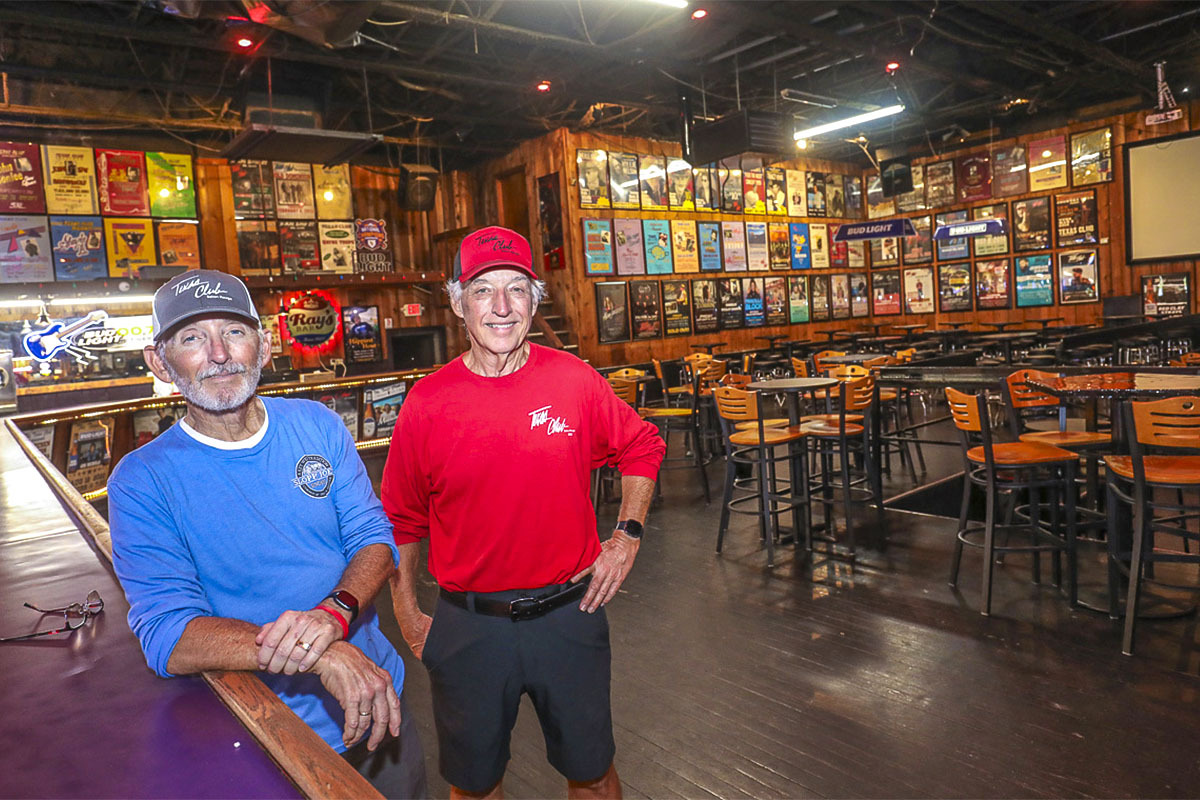 Brothers Mark and Mike Rogers stand next to the bar of the popular Texas Club. In the background, the wall is lined with posters of many of the famous acts that have performed at the venue. / GARY TRAMONTINA PHOTOS
Brothers Mark and Mike Rogers stand next to the bar of the popular Texas Club. In the background, the wall is lined with posters of many of the famous acts that have performed at the venue. / GARY TRAMONTINA PHOTOS
Texas-Sized Bandstand
Back in 1981, brothers Mark and Mike Rogers were working for their father in the auto parts business. But all three were antsy to test their entrepreneurial skills elsewhere, so they did – with a disco, a comedy club and, finally, their pièce de resistance, the Texas Club.
Today, it’s the place Baton Rouge goes to unwind – and where musical acts go to build an audience.
“Back then, the musical acts would go on tour and get discovered by people first,” Mike said. “It’s more organic now.”
One thing that hasn’t changed is the size of the crowds. But how they arrive at the Texas Club is different than in was in the early days.
“When we started people would go out individually and meet others,” Mark said. “Now, people go out in groups. But the good music remains the same. If someone age 65 comes here, I believe they’ll feel like they’re still in their youth.”
Acts have launched meteoric careers here. Commercials have been filmed here. And 68 nights a year, the Texas Club is packed – 1,530 seats strong.
“We’ve gone from Merle (Haggard) to Hank (Williams) Jr. to Jason Aldean, and they keep coming,” Mark said. “We recently had the Red Clay Strays here.”
“That concert,” Mike added, “was like a religious experience.”
One thing that hasn’t changed: “ever since we started, we’ve done business with Regions Bank,” Mike said.
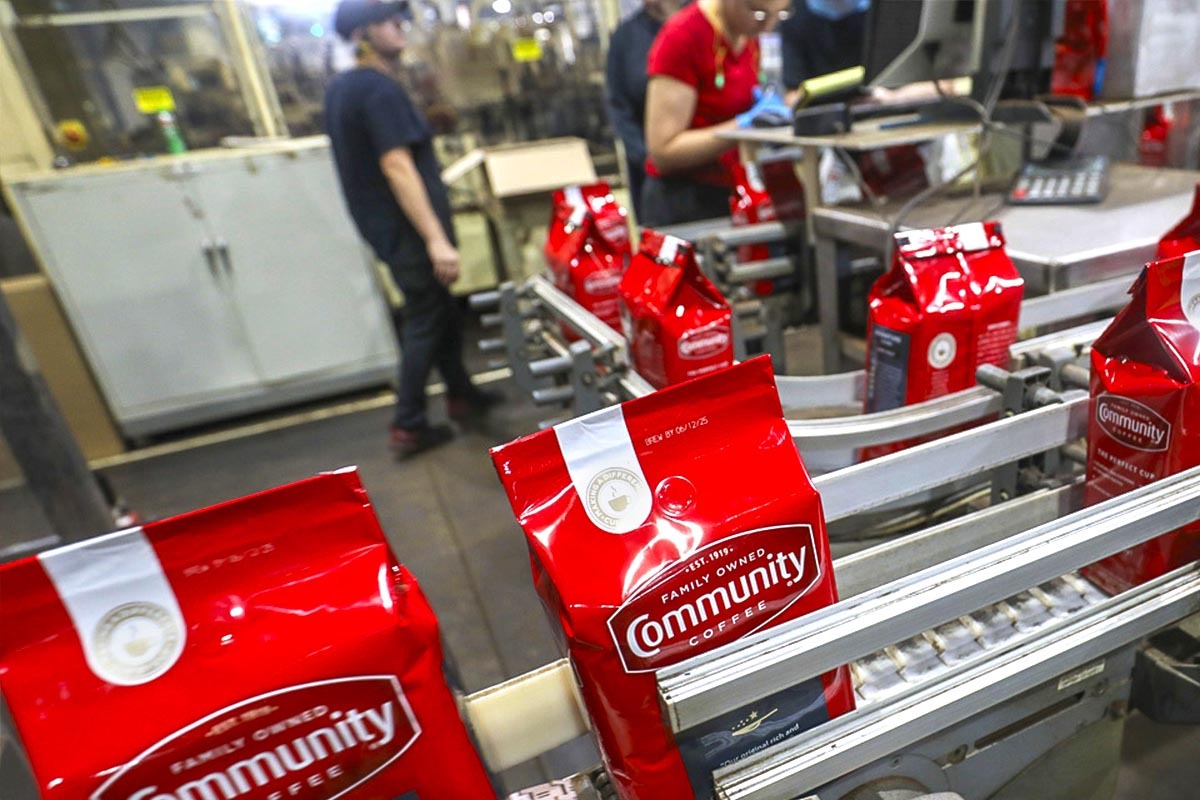
A conveyor belt carries fresh bags of Community Coffee to the next destination./ GARY TRAMONTINA PHOTOS

An employee at Community Coffee wraps packages of coffee for delivery across the U.S.

A Community Coffee employee checks freshly arrived bags of coffee beans.

Regions’ Paula Bradley and Amy Province are all smiles as they begin the day at CC’s Coffee House.

Amy Province, Regions’ market executive in Baton Rouge, at CC’s Coffee House.
Not Your Average Cup of Joe
Henry Norman “Cap” Saurage was known for his great-tasting coffee. Back in 1919, he realized his coffee was much more than a great start to a morning. It connected people.
Five generations later, Community Coffee remains a Baton Rouge institution owned by the Saurage family. Many of the employees of the company, which is based on the river next to the Port of Greater Baton Rouge, have connections that go back generations, as well.
That location is pivotal as Community Coffee takes massive shipments from around the world.
“We have extensive relations with many established farmers who harvest the coffee plants at origin,” said Heather Jones, Senior Manager Corporate Quality and Continuous Improvement at Community Coffee. “Some of these relationships have gone back for decades.”
Taking time out from a hectic day, Jones patiently walks us through the process. And at each step, we are met by friendly employees who obviously enjoy their work. The emphasis on family is strong, as is the pride in Baton Rouge.
“We are so proud to be a Baton Rouge business,” said Tom Corley, President and CEO of Community Coffee. “We cherish this community and the privilege of being based here for over 105 years. We are so grateful to all our employees, fellow citizens and loyal coffee drinkers for their support over the years.”

Soft-shelled crayfish over black drum covered in sauce, the special of the day during our visit to Louisiana Lagniappe Restaurant. / GARY TRAMONTINA PHOTOS

Pecan chicken salad sandwich at Capital City Grill, a popular lunch destination in downtown Baton Rouge. The sandwich is topped with bacon strips and a tomato with fries on the side.

A succulent plate of charbroiled oysters at Drago's, a popular restaurant for both locals and the thousands of sports fans who descend on Baton Rouge.

The gated entrance of the Old State Capitol, where visitors can tour for free.

The ornate interior of the Old State Capitol in Baton Rouge includes a floating staircase and portraits of Louisiana governors.

Visitors to the Old State Capitol study the history of the original statehouse. In the middle of the governor’s office, a sculpture honors Jean Baptiste Bienville, the “Father of New Orleans.”

The new state capitol in Baton Rouge is an art deco skyscraper that towers above downtown.

A statue of Gov. Huey P. Long rises above downtown Baton Rouge, looking directly at the new state capitol Long envisioned.

The old governor’s mansion, located on an oak-lined street just blocks from the Mississippi River, is open for tours.

A sprawling oak tree frames the old Governor’s Mansion. This was the residence of Huey P. Long during his terms in the statehouse.

Portraits of former Louisiana governors adorn the walls in the Old State Capitol.

The Downtown Greenway features an oak-tree shaded path perfect for walking on a humid summer day.

Locals take in a mid-day stroll on the levee with the Mississippi River bridge in the background.

A ship docs at the Port of Greater Baton Rouge. This critical Mississippi River port is the 10th largest in the U.S. and is a vital economic cog for the region. / PHOTO COURTESY OF PORT OF GREATER BATON ROUGE

A train passes through downtown Baton Rouge. In the background, the Horace Wilkinson Bridge spans the mighty Mississippi River.

Steps leading over a breezeway that connects the Mississippi River and downtown Baton Rouge features colorfully painted step art showing off the city with the welcoming, “Explore Baton Rouge.”
Delectable Dishes and Historical Standing
Let’s be honest. If you’re visiting Baton Rouge for the first time or the hundredth, it’s impossible to find a bad meal. This is a serious foodie town, much like its neighbor in New Orleans.
The perfect visit includes dinner at Louisiana Lagniappe, a Baton Rouge staple. It started as a creole-inspired Gulf seafood establishment in Destin, Florida, in 1984, then expanded to Gulf Shores, Alabama, 15 years later. But it’s best known for its hometown Baton Rouge location.
Owner Kevin Ortego has been here from the start, and he hasn’t lost a step as he visits customers while they dine on delicious seafood and steaks. He knows everyone in town, greeting Regions’ Paula Bradley warmly as we dine out and giving us a quick history lesson.
And if it’s history you yearn for, you have two state capitols to choose from.
The current state capitol was the brainchild of Gov. Huey Long, an art deco skyscraper that towers over downtown. It opened shortly after Long left office, only to take on the role of U.S. senator. It’s also where the populist legend took his last breath, the victim of an assassin’s bullet outside the Speaker’s office in 1935.
A short hike away, the old state capitol is also an incredible architectural wonder. Known as Baton Rouge’s Castle, this historic building served as the heart of Louisiana politics for nearly a century and was rebuilt after a 19th-Century fire.
Touring the masterpiece is free, and it includes large oil paintings of former governors, a stunning spiral staircase and stained glass that offers stunning reflections of the sun and equally mesmerizing views of the Mississippi River. A current exhibit tells the story of Jewish lawyers who fought for freedom under Germany’s Third Reich. And an interactive, 4D show tells the tale of the ghost of Sarah Morgan, a Civil War-era figure who so loved the building that she decided to hang around in the afterlife.
After visiting Baton Rouge, we don’t blame her.
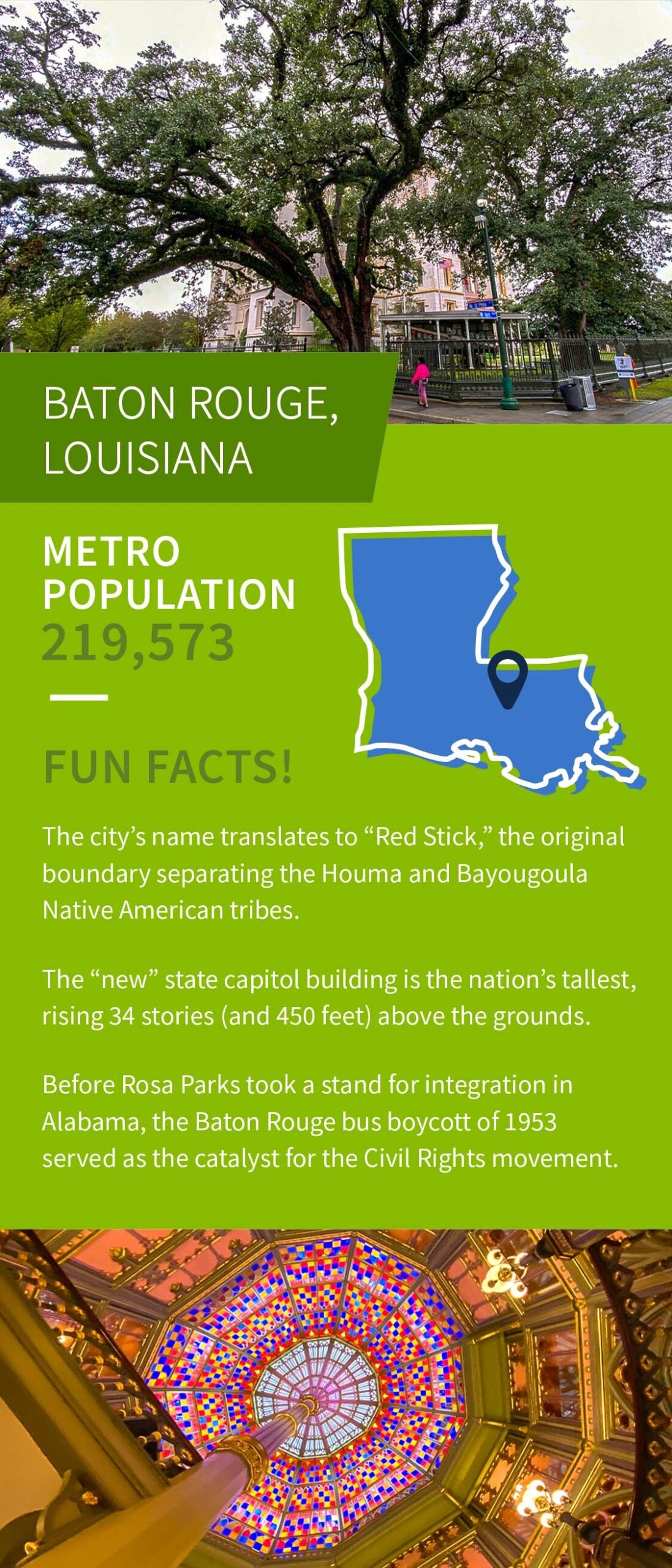
From the Doing More Today Archives: